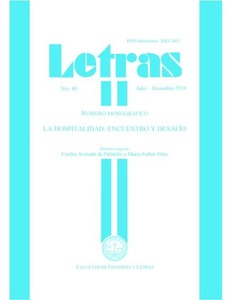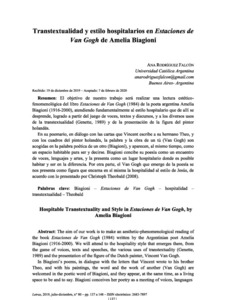Por favor, use este identificador para citar o enlazar este ítem:
https://repositorio.uca.edu.ar/handle/123456789/10679| Campo DC | Valor | Lengua/Idioma |
|---|---|---|
| dc.contributor.author | Rodríguez Falcón, Ana | es |
| dc.date.accessioned | 2020-10-07T22:53:34Z | - |
| dc.date.available | 2020-10-07T22:53:34Z | - |
| dc.date.issued | 2019 | - |
| dc.identifier.citation | Rodríguez Falcón, A. Transtextualidad y estilo hospitalarios en Estaciones de Van Gogh de Amelia Biagioni [en línea]. Letras. 2019, 80. Disponible en: https://repositorio.uca.edu.ar/handle/123456789/10679 | es |
| dc.identifier.issn | 2683-7897 (on line) | - |
| dc.identifier.issn | 0326-3363 | - |
| dc.identifier.uri | https://repositorio.uca.edu.ar/handle/123456789/10679 | - |
| dc.description.abstract | Resumen: El objetivo de nuestro trabajo será realizar una lectura estéticofenomenológica del libro Estaciones de Van Gogh (1984) de la poeta argentina Amelia Biagioni (1916-2000), atendiendo fundamentalmente al estilo hospitalario que de allí se desprende, logrado a partir del juego de voces, textos y discursos, y a los diversos usos de la transtextualidad (Genette, 1989) y de la presentación de la figura del pintor holandés. En su poemario, en diálogo con las cartas que Vincent escribe a su hermano Theo, y con los cuadros del pintor holandés, la palabra y la obra de un tú (Van Gogh) son acogidas en la palabra poética de un otro (Biagioni), y aparecen, al mismo tiempo, como un espacio habitable para ser y decirse. Biagioni concibe su poesía como un encuentro de voces, lenguajes y artes, y la presenta como un lugar hospitalario donde es posible habitar y ser en la diferencia. Por otra parte, el Van Gogh que emerge de la poesía se nos presenta como figura que encarna en sí misma la hospitalidad al estilo de Jesús, de acuerdo con lo presentado por Christoph Theobald. | es |
| dc.description.abstract | Abstract: The aim of our work is to make an aesthetic-phenomenological reading of the book Estaciones de Van Gogh (1984) written by the Argentinian poet Amelia Biagioni (1916-2000). We will attend to the hospitality style that emerges there, from the game of voices, texts and speeches, the various uses of transtextuality (Genette, 1989) and the presentation of the figure of the Dutch painter, Vincent Van Gogh. In Biagioni’s poems, in dialogue with the letters that Vincent wrote to his brother Theo, and with his paintings, the word and the work of another (Van Gogh) are welcomed in the poetic word of Biagioni, and they appear, at the same time, as a living space to be and to say. Biagioni conceives her poetry as a meeting of voices, languages and arts, as a hospitable place where it is possible to live and to be in the difference. On the other hand, the Van Gogh that emerges from the poetry is presented as a figure that embodies in itself Jesus hospitable style, according to what Christoph Theobald develops. | es |
| dc.format | application/pdf | es |
| dc.language.iso | spa | es |
| dc.publisher | Pontificia Universidad Católica Argentina. Facultad de Filosofía y Letras | es |
| dc.rights | Acceso abierto | * |
| dc.rights.uri | http://creativecommons.org/licenses/by-nc-sa/4.0/ | * |
| dc.source | Letras Nº 79, 2019 | es |
| dc.subject | Gogh, Vincent van, 1853-1890 | es |
| dc.subject | ANALISIS LITERARIO | es |
| dc.subject | POEMAS | es |
| dc.subject | HOSPITALIDAD | es |
| dc.title | Transtextualidad y estilo hospitalarios en Estaciones de Van Gogh de Amelia Biagioni | es |
| dc.title | Hospitable Transtextuality and Style in Estaciones de Van Gogh by Amelia Biagioni | es |
| dc.type | Artículo | es |
| uca.disciplina | LITERATURA | es |
| uca.issnrd | 1 | es |
| uca.affiliation | Fil: Rodríguez Falcón, Ana. Pontificia Universidad Católica Argentina. Facultad de Filosofía y Letras; Argentina | es |
| uca.version | publishedVersion | es |
| item.fulltext | With Fulltext | - |
| item.grantfulltext | open | - |
| item.languageiso639-1 | es | - |
| Aparece en las colecciones: | LETRAS - 2019 nro. 80 | |
Ficheros en este ítem:
| Fichero | Descripción | Tamaño | Formato | |
|---|---|---|---|---|
| letras80.jpeg | 21,39 kB | JPEG |  Visualizar/Abrir | |
| transtextualidad-estilo-hospitalarios-biagioni.pdf | 5,68 MB | Adobe PDF |  Visualizar/Abrir |
Visualizaciones de página(s)
141
comprobado en 27-abr-2024
Descarga(s)
111
comprobado en 27-abr-2024
Google ScholarTM
Ver en Google Scholar
Este ítem está sujeto a una Licencia Creative Commons

